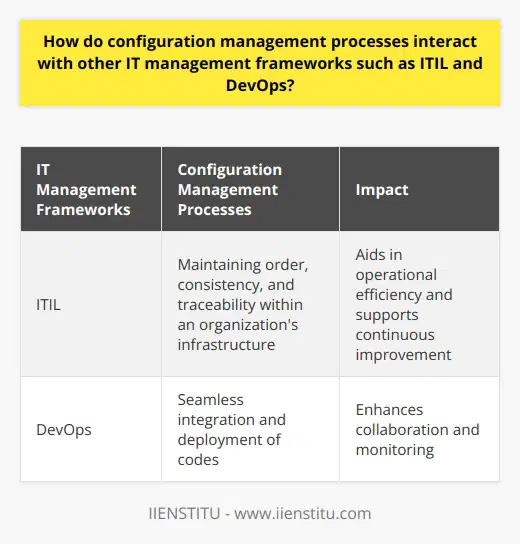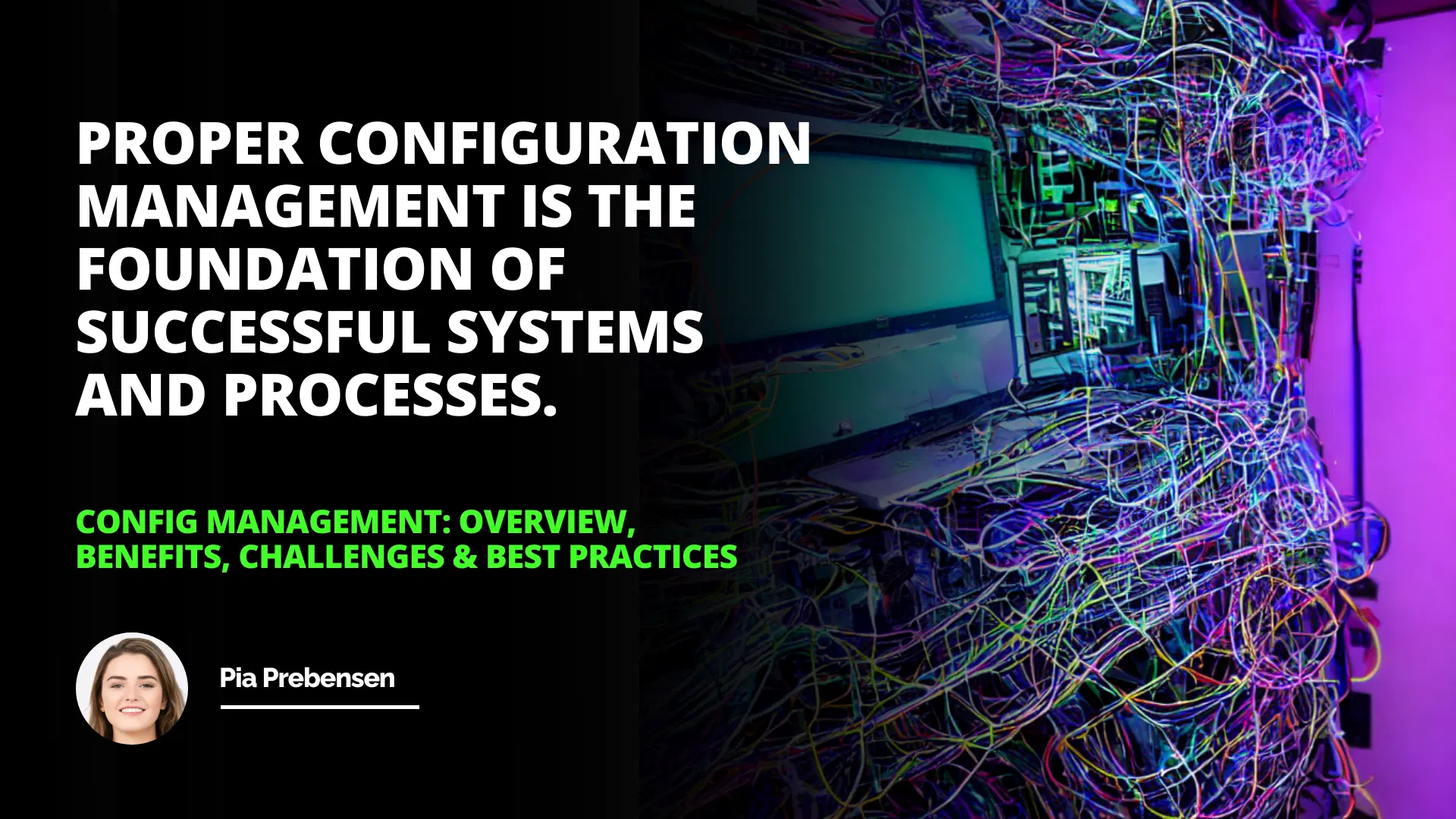
Overview of Configuration Management and Change Management
Benefits of Implementing Configuration Management and Change Management
Challenges of Implementing Configuration Management and Change Management
Tools Used for Configuration and Change Management
Best Practices for Implementing Configuration and Change Management
Configuration Management (CM) is a discipline that helps organizations maintain their IT infrastructure and applications systematically. It also enables them to manage and monitor changes in the system, ensuring that they stay within the organization's desired state. Combined with Change Management (CM), it ensures that changes in the system are tracked, tested, and approved before they are implemented. This article will provide an overview of Configuration Management and Change Management, the benefits of implementing it, the associated challenges, the tools used for it, and best practices for implementing it.
Overview of Configuration Management and Change Management
Configuration Management is the process of tracking, controlling, and maintaining the various components of an IT infrastructure, such as servers, databases, and software. It involves documenting the configuration of each component and ensuring that changes to the system are tracked, tested, and approved before being implemented.
Change Management is managing and controlling changes to IT infrastructure. It involves both the planning and execution of changes to the system and ensuring that they are implemented correctly and promptly. Change Management also includes monitoring and evaluating the changes and identifying and resolving issues.
Benefits of Implementing Configuration Management and Change Management
Implementing Configuration Management and Change Management can bring many benefits to an organization. It helps ensure that all system components are documented, making diagnosing and troubleshooting problems easier. It also allows organizations to identify and address any potential security vulnerabilities quickly. Additionally, it helps organizations reduce the risk of downtime, as changes can be tracked and tested before implementation.
Configuration Management and Change Management also help organizations save time and money by making deploying updates and managing the system easier. By automating the process of tracking, testing, and approving changes, organizations can reduce the number of manual tasks and free up resources for other tasks.
Challenges of Implementing Configuration Management and Change Management
Although Configuration Management and Change Management can benefit an organization, some associated challenges exist. One challenge is that keeping track of all the system components can take time, especially in large, complex systems. Additionally, it can be challenging to ensure that all changes to the system are tracked, tested, and approved promptly.
Another challenge is ensuring that the system is secure. Configuration Management and Change Management can help organizations identify and address security vulnerabilities. However, it is up to the organization to ensure that all changes are implemented securely. Additionally, organizations must ensure they have the necessary resources and expertise to implement and maintain the system.
Tools Used for Configuration and Change Management
Several tools help organizations implement and maintain Configuration Management and Change Management. These tools can range from simple spreadsheets to more complex software solutions. More popular tools include Chef, Puppet, Ansible, and SaltStack.
These tools help automate the process of tracking, testing, and approving changes to the system. They also provide tools for managing the configuration of each component, making it easier to diagnose and troubleshoot problems. Additionally, some of these tools can provide monitoring and alerting capabilities, allowing organizations to identify and address potential security vulnerabilities quickly.
Best Practices for Implementing Configuration and Change Management
When implementing Configuration Management and Change Management, there are a few best practices that organizations should follow. First, they should ensure they have the necessary resources and expertise to maintain the system. It is also essential to ensure that all changes are tracked, tested, and approved before implementation. Additionally, organizations should ensure they have the necessary tools and processes to monitor and evaluate the changes.
Finally, organizations should ensure that all changes are implemented securely. This includes ensuring that all security patches and updates are applied promptly and that any potential vulnerabilities are identified and addressed.
Conclusion
Configuration and Change Management are essential for maintaining and managing any IT infrastructure. They help organizations reduce the risk of downtime, save time and money, and ensure that all changes are tracked, tested, and approved before implementation. However, organizations need to ensure that they have the necessary resources and expertise to implement and maintain the system and the necessary tools and processes to monitor and evaluate the changes. Additionally, organizations should ensure that all changes are implemented securely. Following these best practices can help organizations maximize the benefits of Configuration Management and Change Management.
Proper configuration management is the foundation of successful systems and processes.
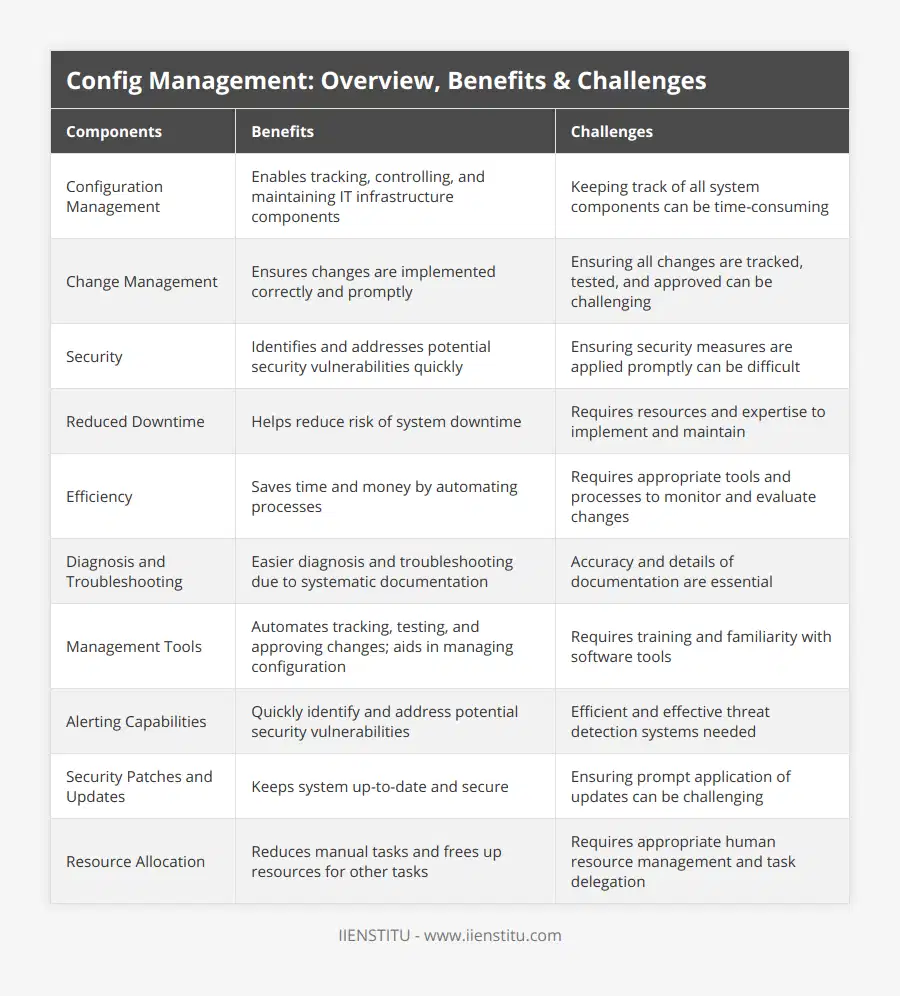
Frequently Asked Questions
What are the benefits of implementing Configuration Management and Change Management?
Configuration and change management are essential processes that help ensure any system's security, stability, and reliability. Organizations can reduce risk, improve efficiency, and increase visibility and control over their IT environment by implementing configuration and change management.
Configuration Management (CM) is a process that ensures that all versions of components in an IT system remain consistent. It includes tracking changes made to the components, maintaining audit trails for compliance requirements, and providing a reference to identify discrepancies between different versions of components. Configuration Management also helps organizations keep track of updates released by vendors or software developers, ensuring that systems are appropriately patched for security vulnerabilities or bugs. This helps reduce the risk of data loss or unauthorized access to systems caused by malicious attacks or outdated software versions.
Change Management (CM) is a process designed to manage changes made to an IT system over time. It involves identifying potential changes in advance, analyzing the impact on other parts of the system before making any changes, and correctly controlling how those changes are implemented within the organization's environment. Change Management also includes keeping track of all approved changes and testing any new functionality before it is rolled out into production. Implementing Change Management ensures that only authorized individuals can make changes in production environments and that all modifications are tracked for traceability.
The benefits associated with implementing Configuration Management and Change Management include
increased security due to consistent control over components,
improved efficiency due to reduced complexity from maintaining multiple versions,
increased visibility through audit trails,
more significant control over IT assets,
Faster resolution times when errors occur since discrepancies can be identified quickly,
improved compliance with industry regulations,
better utilization of resources through automated processes such as patching, and
Maintenance cost savings due to the reduced manual effort required for tracking configurations or updating multiple systems.
In conclusion, Configuration Management and Change Management provide organizations with numerous benefits ranging from improved security and efficiency to cost savings when implemented adequately into their IT environment. However, organizations should evaluate their current processes carefully to determine if they need additional controls, such as CM/CM, to meet regulatory requirements or improve overall performance levels within their organization's environment.
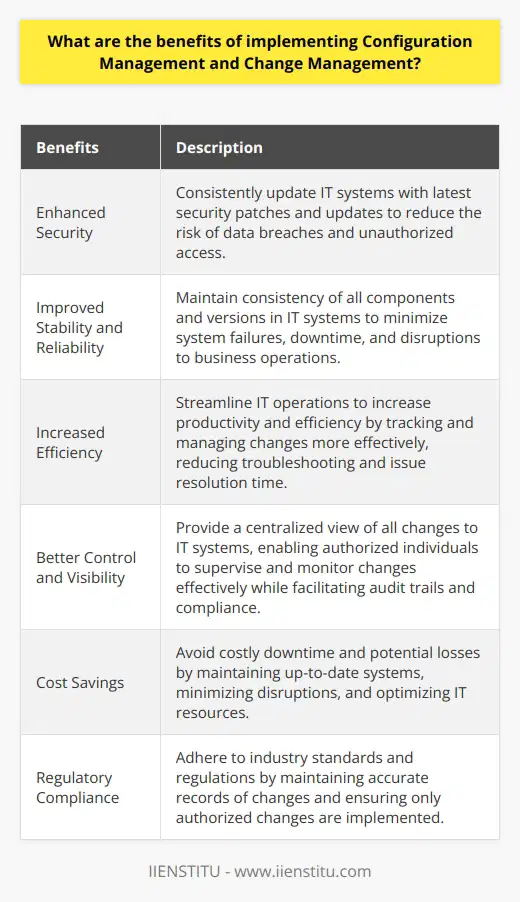
What are the challenges associated with implementing Configuration Management and Change Management?
Configuration and change management are critical components of IT infrastructure and system management. They are essential for developing and maintaining an organization’s IT infrastructure and systems. Implementing these processes can provide an organization with increased efficiency, control, and cost savings. However, several challenges are associated with implementing configuration and change management.
One of the most significant challenges is developing a detailed configuration management plan. This plan must include a detailed description of the organization’s IT infrastructure and systems and the specific processes and procedures that must be followed to ensure the proper functioning of these systems. Additionally, the plan must include a process for tracking IT infrastructure and systems changes. This requires a significant amount of time and resources in order to develop and maintain an accurate and up-to-date configuration management plan.
Another challenge associated with implementing configuration management and change management is the need to establish a security policy. This security policy must include measures to ensure the organization’s IT infrastructure and systems are secure and compliant with applicable laws and regulations. Additionally, the security policy must be regularly reviewed and updated to remain up-to-date. This can be a significant challenge, as it requires an ongoing effort to ensure compliance.
Finally, another challenge associated with implementing configuration and change management is ensuring adequate staff training and support. Staff must be trained in the specific processes and procedures that must be followed in order to ensure the proper functioning of the organization’s IT infrastructure and systems. Additionally, staff must be provided with adequate support to utilize the processes and procedures effectively. This can be a challenge, as it requires an ongoing effort to ensure staff is adequately trained and supported.
In conclusion, implementing configuration management and change management can provide an organization with increased efficiency, control, and cost savings. However, several challenges are associated with implementing these processes, including developing a detailed configuration management plan, establishing a security policy, and providing adequate staff training and support. Organizations must be prepared to invest the time and resources to implement configuration and change management effectively.
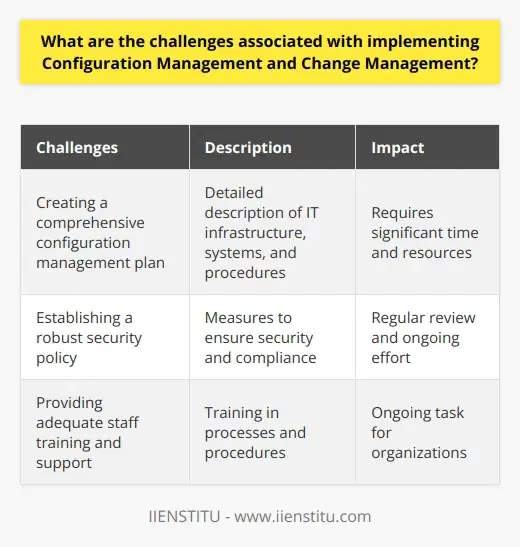
What are the best practices for implementing Configuration Management and Change Management?
When discussing best practices for implementing configuration and change management, it is essential to consider the importance of both processes in an enterprise. Configuration management is a systematic approach to managing the changes that occur in a system over time. It involves tracking, assessing, and controlling changes made to a system about its components, organizational structure, and processes. Change management is the process of controlling and managing changes made to a system by ensuring that all stakeholders are informed of the changes and that they are correctly implemented. Both processes are critical for any organization to maintain control over its systems while ensuring security and stability.
One of the essential best practices for implementing configuration management is establishing a clear set of guidelines that dictate how changes should be handled. These guidelines should include details on who can make changes, what type of change can be made when the change should be implemented, and how it should be tested before being deployed into production. Additionally, organizations should ensure they have adequate resources to effectively manage configuration changes, such as dedicated personnel or tools that automate certain process parts. Finally, there must be an established process for documenting any configuration or change decisions so that they can be tracked over time.
When implementing change management best practices, organizations need to ensure they have an effective communication plan in place for informing stakeholders about upcoming changes and providing them with adequate training if needed. It is also essential that organizations have established policies around who has the authorization to make certain types of changes as well as procedures detailing how those requests should be managed from start to finish before being deployed into production environments. Finally, organizations must ensure an appropriate testing procedure is in place so any potential problems with new implementations can be identified before deployment, avoiding unnecessary downtime or data loss due to faulty implementations.
In conclusion, proper implementation of configuration and change management processes are essential for any organization looking to maintain control over its systems while ensuring their security and stability. Establishing clear guidelines around who can make which type of change, along with robust communication plans, will help ensure successful implementations while minimizing the disruption caused by faulty deployments or unauthorized modifications
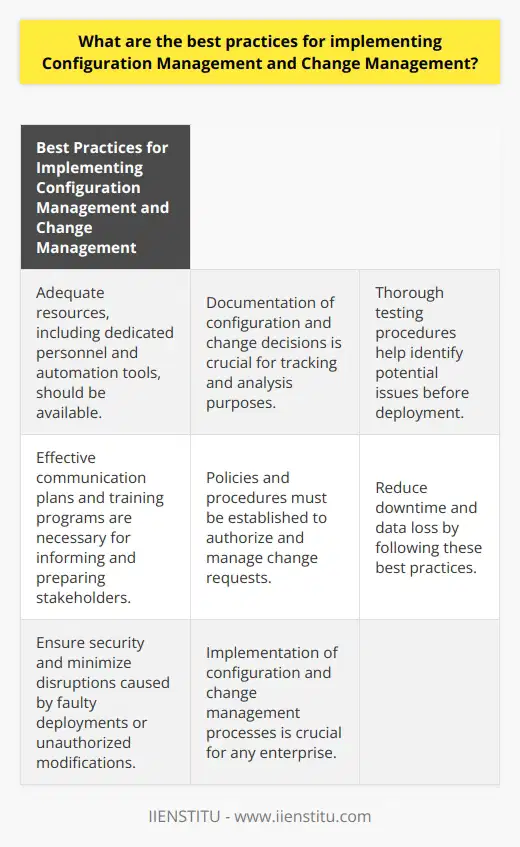
What are the key benefits of configuration management?
**Enhanced System Efficiency**
One of the key benefits of configuration management is the enhancement of system efficiency. By systematically organizing and controlling system components, configuration management facilitates seamless integration and interoperability among diverse elements. This streamlines processes and minimizes errors, leading to a more efficient overall system.
**Improved Visibility and Accountability**
Configuration management enables increased visibility and accountability by providing a documented record of system changes over time. This documentation is invaluable in tracking the evolution of a system, as it allows managers to pinpoint the sources of issues and the individuals responsible for them. This aids in decision-making and promotes a culture of accountability among team members.
**Reduced Risks and Costs**
Another significant advantage of configuration management is the reduction of risks and costs. By proactively identifying and addressing potential issues in a system, configuration management prevents costly failures and outages. Furthermore, configuration management reduces the labor and resources required to maintain a system, ultimately leading to significant cost savings.
**Enhanced Change Management**
Configuration management fosters effective change management by establishing a comprehensive framework for implementing and monitoring modifications. This framework ensures that changes are executed consistently and in alignment with established processes, enabling organizations to adapt to new requirements swiftly and efficiently.
**Increased Security**
Lastly, configuration management contributes to an increased level of security. By maintaining an up-to-date repository of system configurations, it becomes easier to verify the integrity of the infrastructure and identify and address potential vulnerabilities. This proactive approach to security significantly reduces the chances of unauthorized access and data breaches.
In conclusion, configuration management offers numerous benefits to organizations, such as increased system efficiency, visibility, and security; enhanced change management; and reduced risks and costs. By implementing configuration management practices, organizations can enjoy increased stability, control, and adaptability in their IT infrastructure, leading to overall improved performance and success.
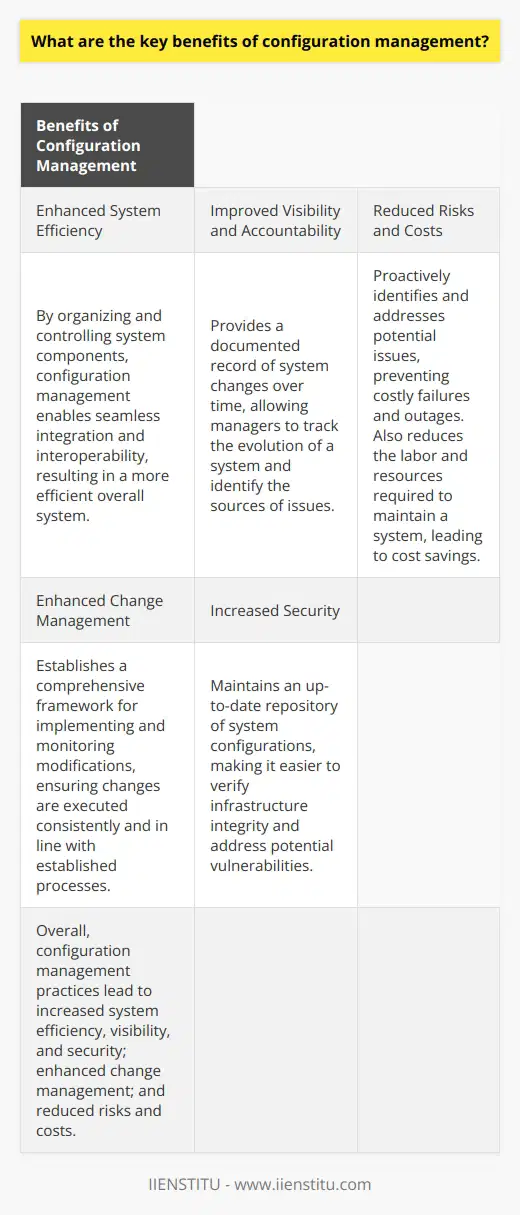
What is the overview of configuration management?
Overview of Configuration Management
Definition and Purpose
Configuration management (CM) is a systematic approach to manage, maintain, and document changes made to software, hardware, and other system components. It involves setting up a standardized process for controlling and monitoring the dynamic aspects of a product or system throughout its lifecycle. The primary purpose of CM is to ensure the reliability, consistency, and traceability of a product or system. This is achieved by understanding and managing the interdependencies between various components and preventing errors due to uncontrolled changes.
Key Components
A configuration management system consists of several key components, which are crucial for its successful implementation. These components include:
Configuration Items (CIs): These are individual elements of a system, such as hardware, software, documentation, or other components that can be managed and identified as a single entity.
Configuration Baselines: These are snapshots of the system's state at specific points in time, which serve as a reference point for comparison and control.
Configuration Identification: This is the process of labeling and uniquely identifying configuration items and their documentation, for easy tracking and retrieval.
Configuration Control: This refers to the management and coordination of changes made to configuration items and associated documentation throughout their lifecycle.
Configuration Status Accounting: This involves the tracking and reporting of configuration item status, the approval or rejection of proposed changes, and the maintenance of a configuration database.
Configuration Audits: These are reviews conducted to ensure adherence to defined processes, procedures, and quality standards. Configuration audits help maintain consistency, traceability, and compliance with industry and organizational guidelines.
Benefits and Applications
Implementing an effective configuration management system is critical for organizations that aim to develop, maintain, and operate complex systems or products within budget and timeline constraints. The benefits of CM are evident in various industries such as aviation, automotive, information technology, energy, and defense.
Some of the key advantages of configuration management include:
Improved traceability and visibility of components and their changes, allowing for more informed decision-making.
Enhanced ability to maintain system stability by controlling and validating changes made to the system.
Greater collaboration between team members, resulting in streamlined workflows and reduced redundancy.
Better compliance with industry standards and regulations through consistent and auditable processes.
Reduced operational costs and increased system reliability by minimizing the risk of errors or conflicts caused by uncontrolled changes.
In conclusion, configuration management plays a vital role in controlling and maintaining the integrity of complex systems throughout their lifecycle. By incorporating a standardized configuration management approach, organizations can increase efficiency, reduce risks, and deliver high-quality products that meet or exceed customer expectations.
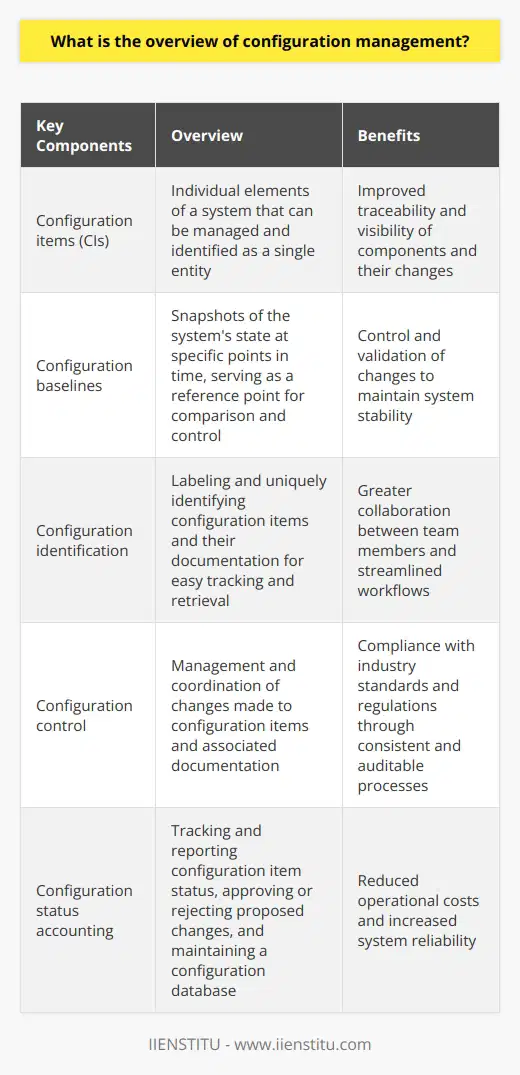
What are the issues in configuration management?
Challenges in Configuration Management
**Complexity and Interdependencies**
One major issue in configuration management is the increasing complexity and interdependencies of systems and components. As technology continues to evolve, organizations must manage numerous configurations across various platforms, which becomes increasingly challenging. This necessitates a coordinated approach to effectively manage these intricacies and ensure seamless integration of components.
**Maintaining Consistency**
Another challenge in configuration management is maintaining consistency across different systems and platforms. Efficient configuration management ensures that any changes made to a system's configuration do not disrupt its overall functionality. Maintaining consistency can be particularly challenging in environments with frequent deployments, as the risk of misconfigurations increases.
**Compliance Requirements**
Organizations must comply with various regulatory and industry guidelines to ensure data security and prevent data breaches. Compliance requirements impose additional challenges on configuration management, such as conducting regular audits and assessments. Failure to meet these requirements can result in legal and financial consequences for the organization.
**Scalability and Adaptability**
Effective configuration management systems must be scalable and easily adaptable to accommodate the growth and evolution of organizations. Outdated or inadequate tools and processes can hinder the ability to manage complex systems and adapt to change. Organizations must therefore invest in robust and flexible configuration management solutions to meet future demands.
**Human Errors and Communication**
Human errors often result in misconfigurations in configuration management. The complexity of systems and processes, along with the need for collaboration across different teams, contributes to the difficulty in avoiding errors. Improving communication and providing relevant training for personnel can reduce the likelihood of human errors in configuration management.
**Automation Limitations**
Automation is commonly utilized to simplify and streamline configuration management tasks. However, automation can also introduce new challenges, such as managing automated tasks and maintaining the integration between tools and systems. Additionally, relying too heavily on automation can sometimes overlook the importance of human judgement and decision-making in the configuration management process.
In conclusion, addressing issues in configuration management requires a comprehensive understanding of the associated complexities, maintaining consistency, adhering to compliance requirements, prioritizing scalability and adaptability, minimizing human error, and recognizing the limitations of automation. Developing strategies that address these challenges is crucial for organizations striving to achieve efficient configuration management and a high-performing IT environment.
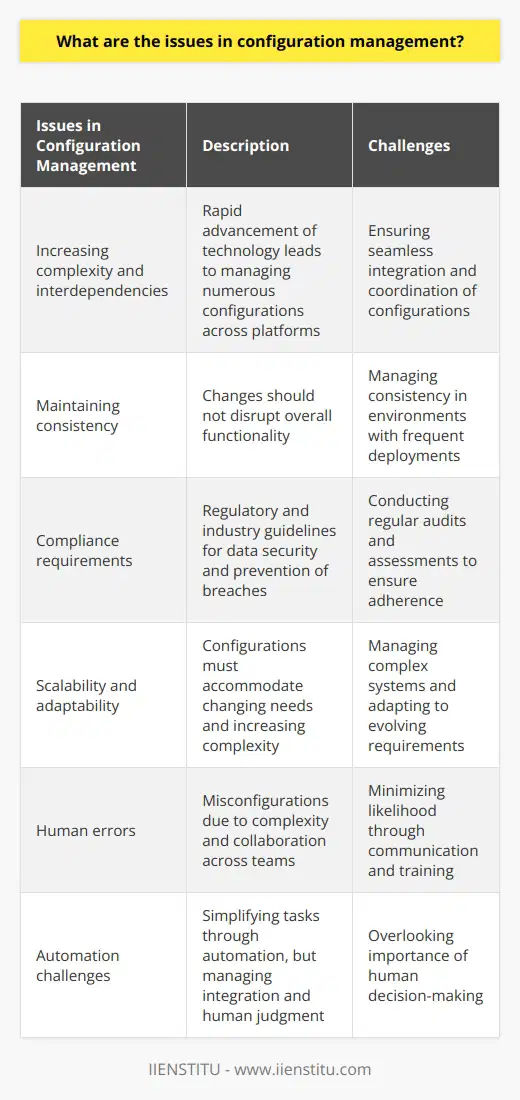
What are the purposes of configuration management?
**Key Objectives of Configuration Management**
Configuration management serves several purposes in the context of software and systems development. The primary goal is to maintain system consistency throughout its lifecycle, ensuring reliable and predictable performance. It achieves this by providing a systematic approach to managing and controlling changes to the system.
**Change Control and Traceability**
One significant purpose of configuration management is to establish and enforce change control processes. These processes involve identifying proposed alterations, evaluating the potential impacts, and ensuring proper authorization before implementation. By doing so, configuration management minimizes disruptions and maintains system integrity.
**Facilitating Communication**
Another vital purpose is facilitating communication among stakeholders, such as developers, testers, and project managers. Configuration management ensures that everyone involved in the project has access to relevant information and stays updated on the system's current state. This access promotes transparency and enables more effective collaboration.
**System Reproducibility**
System reproducibility is another essential objective achieved through configuration management. By consistently recording changes and maintaining historical data, the configuration management process allows developers to recreate previous configurations if needed. This ability is crucial for troubleshooting, auditing, and performing root-cause analysis on unexpected issues.
**Standardization and Compliance**
Configuration management also contributes to standardization and regulatory compliance. By utilizing established protocols and guidelines, it helps ensure that the system adheres to industry standards, best practices, and applicable regulations. This adherence not only supports system quality but also meets the demands of various stakeholders.
**System Optimization**
Finally, configuration management plays a role in system optimization. By monitoring configurable items and their relationships, it allows for the identification of potential improvements or areas where redundancy exists. These findings enable the elimination of inefficiencies, leading to more streamlined and cost-effective operations.
In conclusion, configuration management serves multiple purposes in the development and maintenance of software and systems. By regulating change control, facilitating communication, ensuring system reproducibility, upholding standardization and compliance, and promoting optimization, it contributes to overall system quality, stability, and efficiency.
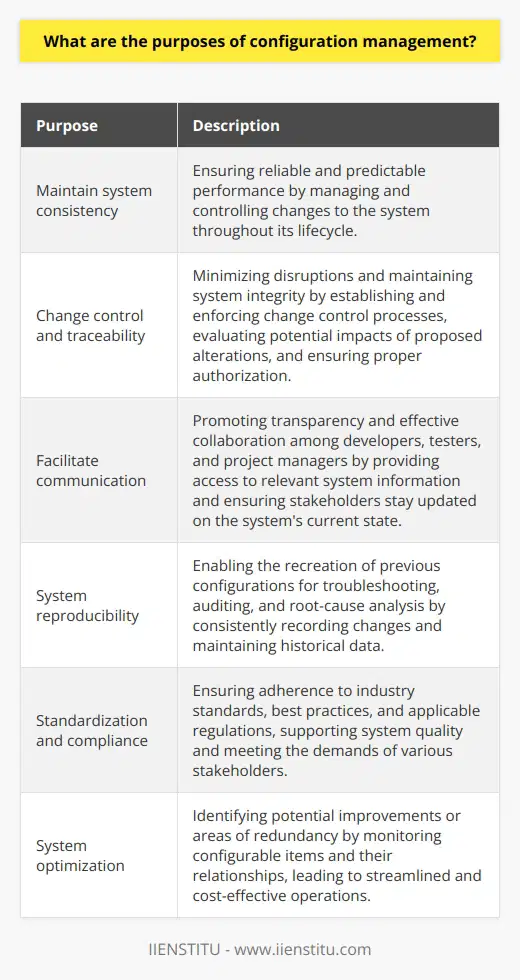
How does configuration management improve system reliability and security?
Enhanced System Reliability
Configuration management significantly enhances system reliability by meticulously tracking and controlling all changes made to the system components. It establishes a single source of truth, thus enabling teams to accurately analyze and assess the system's performance. By maintaining a thorough record of configuration changes, teams can revert to stable states in case of issues or failures. Additionally, a well-implemented configuration management plan helps in detecting and resolving conflicts and redundancies in a timely manner. This leads to improved stability, fewer outages, and overall better system performance.
Robust Security Management
The role of configuration management in security is critical, as it aids in the identification, assessment, and mitigation of security vulnerabilities. A systematic approach to managing and documenting changes reduces the risk of unauthorized modifications, ensuring that the system maintains its intended secure state. By implementing a configuration management process, organizations can maintain a comprehensive inventory of their assets and recognize potential risk factors. This increases their preparedness in addressing potential security threats and maintaining a robust security posture.
Monitoring and Auditing
Regular monitoring and auditing of system configurations are vital components of a successful configuration management process. These practices allow organizations to ensure adherence to industry best practices, regulatory requirements, and internal policies. Furthermore, periodic checks and reviews help to identify any deviations or non-compliance, prompting remedial action to restore the system to its desired state. With the proper monitoring and auditing system in place, security breaches are vastly reduced, and overall system integrity is maintained.
Continuous Improvement
Configuration management fosters a culture of continuous improvement, as it encourages teams to persistently review and refine the system based on performance feedback and updated security measures. This iterative process enables organizations to stay current with industry advancements, ensuring a consistently high-reliability and security standard in their systems. Consequently, the system becomes more capable of adapting to evolving technological and security landscape changes, resulting in long-term stability and resilience.
In conclusion, configuration management significantly contributes to system reliability and security by promoting a structured, consistent approach to managing and documenting changes. This effective management strategy minimizes the risk of unplanned outages or breaches, while maintaining a strong, adaptable system infrastructure.
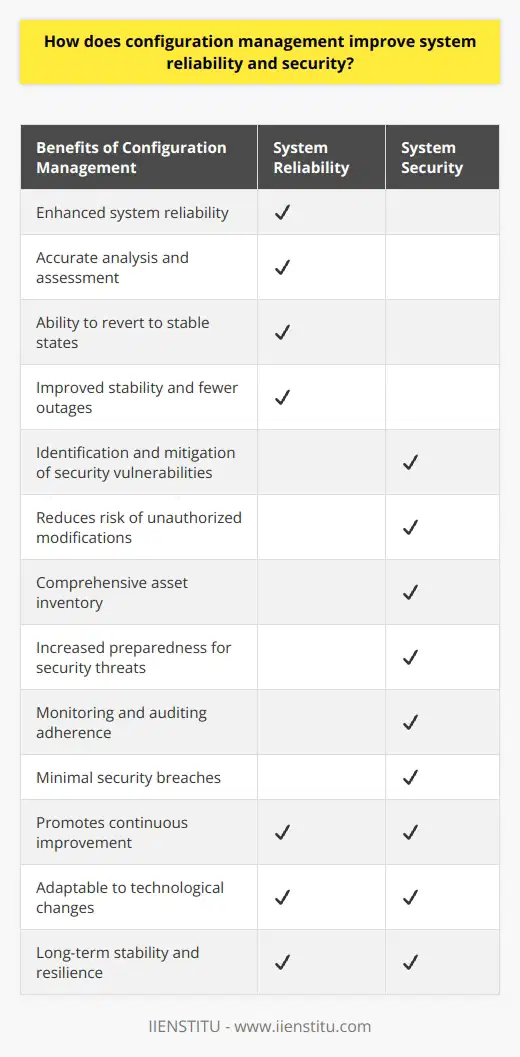
What are the primary activities involved in effective configuration management?
Primary Activities in Configuration Management
Identification of Configuration Items
Effective configuration management begins with the identification and selection of configuration items (CIs). CIs refer to any hardware, software or documents that are essential for a successful project completion. All such essential components should be cataloged, indexed and uniquely distinguished, along with their functional and physical attributes. This helps create a reliable, easily accessible and consistent knowledge base.
Change Control and Management
Initiating changes to CIs, only after the proper approval and documentation of the request, is another crucial activity. Ensuring transparency and a robust review process during the alteration of CIs helps teams maintain an organized and controlled environment. Stakeholders should be kept informed and involved throughout the change process, thus enabling better risk management and decision-making capabilities.
Version and Baseline Control
An efficient configuration management system must ensure proper version and baseline control. This involves tracking each CI's life cycle while providing visibility of its current and previous versions. Moreover, a baseline—a snapshot of the project's configuration status at a specific point in time—must be determined and maintained to facilitate comparisons, assessments and evaluations. Regular audits and reviews can help significantly in maintaining the integrity of the baselines.
Release and Deployment Management
Any amendments made to a CI should be subjected to release and deployment management, which includes planning, testing, and implementing any changes in a structured manner. These processes help in minimizing disruptions, ensuring smooth integration of new or updated CIs into the existing infrastructure, as well as improving overall system stability and reliability.
Continuous Monitoring and Audits
Regular monitoring, assessments and audits are essential for maintaining the effectiveness of a configuration management system. Monitoring involves tracking and evaluating the status of CIs and the project itself, while audits check on the accuracy and relevance of the records, baselines, and other information related to a CI's performance. These activities support active risk management, aiding to identify potential issues or inconsistencies that may impact the project's effectiveness.
In conclusion, the primary activities in effective configuration management involve identification of configuration items, change control and management, version and baseline control, release and deployment management, and continuous monitoring and audits. These activities ensure that an organized and controlled environment is maintained, allowing for efficient and successful project completion.
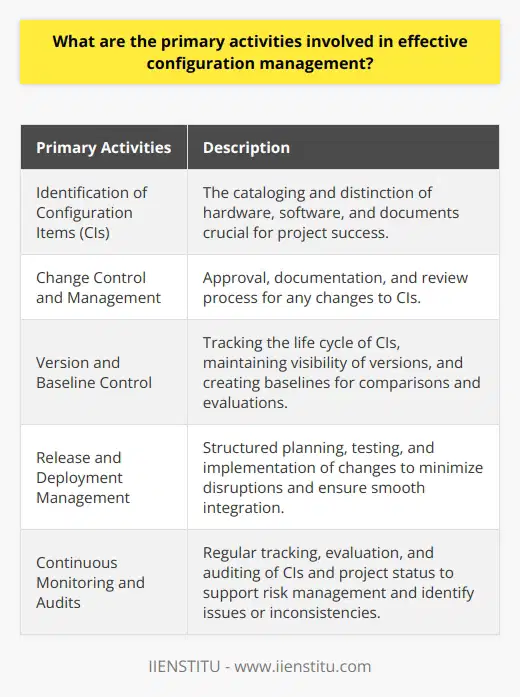
What are three benefits of configuration management for servers?
Optimizing Server Operations
Configuration management offers numerous advantages for server administration, with three notable benefits being streamlined operations, enhanced security, and improved disaster recovery protocols. These benefits contribute to efficiently maintaining and optimizing server performance, ultimately providing a better user experience and reducing the likelihood of system failures.
Streamlined Operations
Firstly, configuration management systems facilitate streamlined server operations by automating otherwise labor-intensive tasks. These tasks include deploying new applications, installing updates, and configuring settings across multiple servers. Automation assists in reducing the risk of human error while allowing system administrators to focus on other critical tasks, such as strategizing for future expansion and enhancements.
Enhanced Security
Another significant benefit of configuration management is its ability to boost server security. With the prevalence of cyber threats, ensuring that servers are securely configured has become crucial. Configuration management systems enable the monitoring of server settings, which helps in identifying security vulnerabilities and ensuring timely application of patches. Additionally, these systems enforce consistent security policies and roles across servers, thus minimizing the risk of unauthorized access and data breaches.
Improved Disaster Recovery
Configuration management also plays a critical role in developing robust disaster recovery plans. In the event of a server failure, it is vital to have access to up-to-date configurations to facilitate the restoration process promptly. Configuration management systems not only back up these configurations but also track their changes over time. This historical data allows system administrators to identify the most stable configurations and recover servers more efficiently, ultimately minimizing downtime and associated costs.
In conclusion, configuration management offers vital benefits for server administration in streamlining server operations, enhancing security measures, and improving disaster recovery protocols. By automating processes and providing comprehensive oversight of server configurations, system administrators can ensure the consistent performance and reliability of their infrastructure.
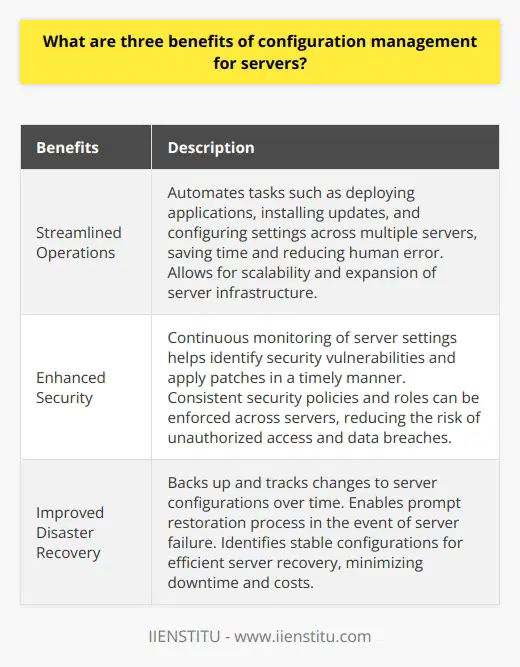
How do configuration management tools facilitate software development and operations?
Role of Configuration Management Tools
Configuration management tools play a crucial role in streamlining software development and operations workflows. These tools ensure efficient and consistent deployment, providing a structured and organized approach to managing software configurations.
Automating Configuration Processes
Through automation, configuration management tools minimize manual processes and reduce the risk of human error. This automation contributes to increased productivity among software development teams by providing them with a single source of truth. By tracking changes and constantly updating configurations, these tools ultimately lead to a more robust software architecture.
Facilitating Collaboration
These tools also promote collaboration within the development and operations teams. By providing a central repository for configurations, they enable developers to share information, work together more efficiently, and ensure that all team members are aware of the current project status. This collaboration results in improved communication, faster problem resolution, and reduced risk of project failure.
Maintaining Consistency and Compliance
Consistency in software configurations is essential for effective development and operations. Configuration management tools help maintain consistency by tracking changes, providing version control, and automatically applying the necessary updates. In addition, these tools ensure compliance by enforcing predefined policies and best practices, and by generating reports to monitor and measure adherence to the set standards.
Enhancing Accessibility and Scaling
Lastly, configuration management tools enhance accessibility and scaling of software development and operations. By providing a centralized platform accessible by multiple team members, these tools make it easier to manage large-scale projects and accommodate growth. Cloud-based solutions further contribute to seamless scaling by offering flexible storage options and facilitating remote team collaboration.
In conclusion, configuration management tools have become indispensable in the software development and operations landscape. By automating processes, promoting collaboration, ensuring consistency and compliance, and enhancing accessibility and scaling, these tools contribute to the overall efficiency and success of development projects.
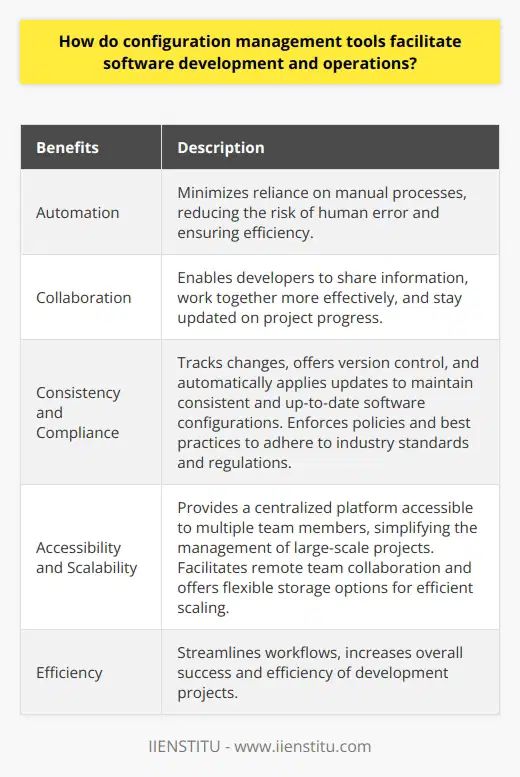
What are some common challenges faced during the application of configuration management in an organization?
Challenges in Implementing Configuration Management
Understanding Complexity
One of the common challenges faced during the application of configuration management in an organization is understanding the complexity of the task. This includes managing various hardware and software components, as well as their relationships and dependencies, which require extensive knowledge and coordination on multiple levels.
Scalability Issues
Organizations often encounter scalability issues when implementing configuration management. As the company grows, the number of devices, systems, and software applications increases exponentially. This added complexity requires more resources and manpower to effectively manage configurations, maintain consistency, and track changes.
Change Management
Effective configuration management is closely related to change management. Organizations frequently struggle with the process of controlling and documenting changes, which can result in inconsistencies and potential system failures. Coordinating changes across different departments and ensuring the right communication channels are in place is crucial for successful configuration management.
Lack of Resources
Many organizations face challenges in terms of resources when it comes to implementing configuration management. This includes not only a lack of skilled professionals but also insufficient tools and systems that can streamline the process. Proper investment in training and resources is necessary for adequate configuration management.
Knowledge Silos
A major challenge of configuration management is overcoming knowledge silos within an organization. Knowledge silos occur when crucial information is only known by specific individuals, making it difficult for others to access or understand. Configuration management requires information sharing and collaboration among different departments and individuals to ensure alignment.
Tool Integration
Organizations might use multiple tools for configuration management. Ensuring these tools are integrated and work seamlessly together can be a challenge. Gaps in tool integration can result in inaccuracies, inconsistencies, and flawed processes, making it more difficult to maintain control over the organization's infrastructure.
Conclusion
In summary, organizations face numerous challenges when implementing configuration management, including understanding complexity, scalability issues, change management, lack of resources, knowledge silos, and tool integration. Addressing these challenges is crucial to enhance the effectiveness of configuration management and ultimately contribute to the successful functioning of the organization.
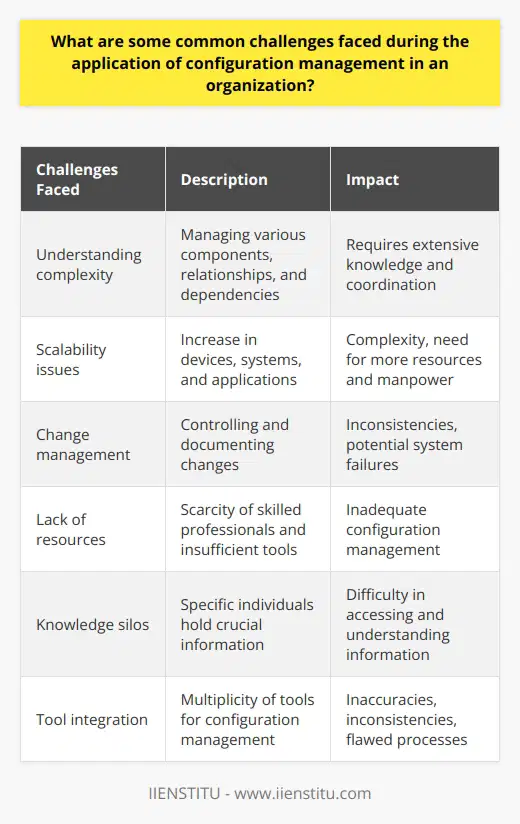
What are the 5 pillars of configuration management?
The Core Principles of Configuration Management
Understanding the Five Pillars
Configuration management refers to the process of systematically handling changes in a system to ensure its consistency, functionality, and reliability. Within this domain, five fundamental pillars have been established as guidelines for effective implementation. These pillars are identification, control, accounting, audit, and status reporting.
Identification of Configuration Items
In configuration management, it is crucial to identify and label each configuration item (CI) accurately. These items include hardware components, software applications, and documentation. Proper identification enables efficient tracking and control of changes throughout the system, preventing potential conflicts and enhancing system reliability.
Control of Changes
Change control is the process of managing and authorizing modifications to configuration items. It involves recording each alteration, submitting it for approval, and implementing it gracefully. By employing well-defined change control procedures, an organization can ensure the stability of the system while incorporating necessary updates or enhancements.
Accounting for Configuration Items
Configuration accounting is the process of maintaining accurate and up-to-date records of configuration items, their attributes, and relationships. This includes maintaining a configuration management database (CMDB), which serves as a central repository of information about an organization's IT infrastructure. Effective configuration accounting ensures that a system remains in compliance with its established baselines, making it easier to trace and resolve issues.
Audit and Verification
Regular audits are essential to assess the correctness of the configuration management process. This involves comparing the actual configuration items and their attributes in the system against the documented information in the CMDB. Audits help identify discrepancies, enforce compliance with internal standards and external regulatory requirements, and recommend corrective actions to maintain system integrity.
Status Reporting and Communication
Providing timely and relevant configuration status reports ensures that stakeholders are informed about the current state of the system. These reports outline the details of changes made, the rationale behind them, and any impacts on the system's performance. By establishing clear lines of communication, configuration management supports informed decision-making and fosters a more proactive approach to maintaining system stability.
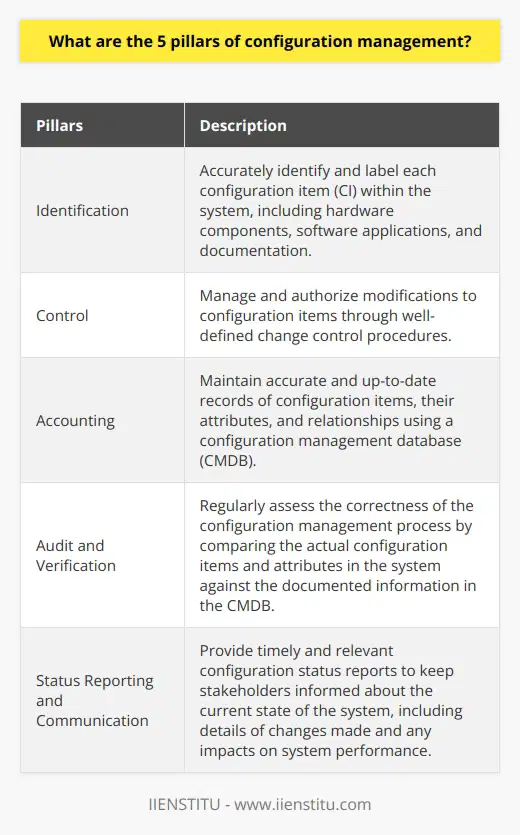
How does configuration management contribute to project success and overall organizational efficiency?
**Role of Configuration Management in Project Success**
Configuration management is a crucial factor in the success of a project as it ensures the proper identification, documentation, and control of project components. By maintaining detailed records and monitoring changes to these components, project managers have a comprehensive understanding of the project's current state, allowing them to make informed decisions for adjustments or improvements. This transparency helps maintain the quality and consistency of project deliverables, which ultimately contributes to the overall project success.
**Enhancing Organizational Efficiency**
Furthermore, configuration management significantly contributes to overall organizational efficiency through streamlined processes and reduced risk. By creating a standard methodology for capturing and administering project element information, organizations can reduce errors and duplications, leading to a more efficient use of resources in developing, testing, and deploying project deliverables. With a centralized repository for project data, team members can effectively collaborate on tasks, enabling a smooth flow of activities from planning to implementation.
**Facilitating Adaptability & Innovation**
A well-established configuration management system supports adaptability and innovation within an organization. As changes occur in technology, regulation, or market demands, organizations need to respond swiftly to maintain competitiveness. Configuration management processes enable organizations to adapt to these shifting circumstances by providing a clear overview of current and past project states, facilitating efficient reconfiguration in response to evolving requirements.
**Ensuring Compliance & Security**
Finally, configuration management helps maintain compliance with industry-specific regulations and standards by ensuring that all project components adhere to established guidelines. A standardized documentation process within configuration management enables organizations to demonstrate compliance during audits and inspections. Moreover, effective control of project elements enhances security by preventing unauthorized changes and reducing the risks associated with human error or malicious intent.
In conclusion, configuration management plays a pivotal role in project success and organizational efficiency. By providing a systematic approach to managing project components, configuration management supports the delivery of high-quality and consistent outputs, streamlines organizational processes, encourages adaptability in response to change, and ensures compliance and security measures are upheld.
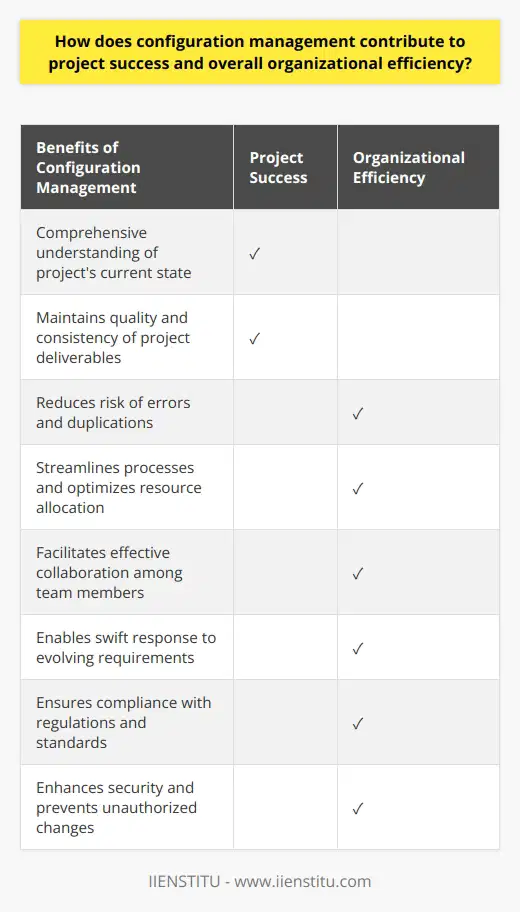
How do configuration management processes interact with other IT management frameworks such as ITIL and DevOps?
Interaction with ITIL Framework
Configuration management processes are critical for maintaining order, consistency, and traceability within an organization's infrastructure. The Information Technology Infrastructure Library (ITIL) framework, which is commonly adopted by large-scale enterprises, utilizes configuration management as an essential process in its service lifecycle. ITIL's configuration management deals with the identification, control, and documentation of all the configuration items (CIs) within the infrastructure, ensuring accurate and up-to-date information during the entire service lifecycle.
Integration with DevOps Practices
In recent years, the DevOps methodology has gained prominence for its emphasis on collaboration, automation, and continuous delivery of high-quality software. Configuration management plays a vital role in supporting DevOps practices, as it facilitates seamless integration and deployment of codes by maintaining stable environments. It aids in building and maintaining infrastructure as code (IAC), which allows for consistent configuration and deployment across multiple environments. This enhances collaboration between development and IT operations teams, as they can rapidly test, modify, and deploy changes without any disruptions.
Monitoring and Control
Both the ITIL framework and DevOps practices emphasize the importance of monitoring and control in achieving operational efficiency. Configuration management processes contribute to monitoring by tracking changes made to configuration items and their potential impact on services. This data enables accurate decision-making regarding changes to the infrastructure, allowing organizations to maintain stability and avoid disruptions. Additionally, configuration management processes can automatically enforce policies and controls, ensuring that only authorized changes are implemented within the system.
Continuous Improvement
Configuration management processes, ITIL, and DevOps all share a common goal of continuous improvement. ITIL's Plan-Do-Check-Act (PDCA) model emphasizes constant evaluation and improvement of processes, while DevOps promotes iterative development and continuous delivery. By implementing and refining configuration management processes, organizations can identify areas of improvement, optimize performance, and ensure that IT services can evolve with the changing demands of the business.
In conclusion, configuration management processes play an integral role in supporting IT management frameworks such as ITIL and DevOps. By ensuring consistency, traceability, and control over configuration items, these processes enhance collaboration, monitoring, and continuous improvement within the organization. The synergies created between configuration management, ITIL, and DevOps help drive efficiency and effectiveness in IT service delivery, ultimately benefitting both the organization and its customers.
